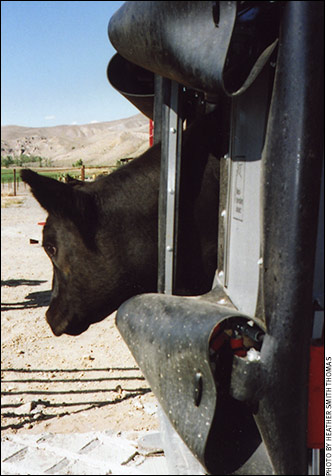Human Safety Issues
Stay safe when vaccinating cattle.
Nora Schrag, veterinarian with the Kansas State University College of Veterinary Medicine, says it’s important to walk beforehand through the facilities that you’ll be using to hold, sort and restrain cattle. She recommends noting anything that might be dangerous to the crew, like pipes used behind animals to stop them from backing up. Also make note how gates swing and which direction levers go.

Nora Schrag says knowing where to stand safely around the squeeze chute will prevent injuries.
“Depending on what kind of squeeze chute you have, if you are standing in the wrong spot when an animal is released, or your head is in the wrong place, you may get hurt. Make sure your crew — whoever will be working there, especially if some are not used to working around cattle, or [are] new to your particular facility — know about the danger areas,” she explains.
It’s also good to do some human safety reminders. If too many people are working and rushing, there is more likelihood of accidents occurring, like getting poked with a needle, says Schrag.
“I sometimes have students helping who are inexperienced. I always stress that they need to be aware of every person and every animal around them. This is wise, even for people who are very experienced. Keep safety precautions in mind,” she says. It pays to do things in a routine, safe way.
“When you are refilling or holding a syringe, always keep your elbows down at your sides. Then if someone walks past you, they’re not as likely to bump your elbow and move your hand,” she explains.
“If you are refilling and handling syringes, one of the dangers is accidentally poking yourself or someone else,” she continues. “Most vaccines aren’t dangerous to humans, but blackleg can cause a serious inflammatory reaction. Avoiding accidental needle pokes should be high priority.”
Keep your elbows at your sides, and if you are holding a bottle to refill your syringe, stick out one finger and touch your other arm for stability and steadiness, she recommends. Then if someone bumps you, there’s no way the needle will jump into your hand, because you already have your hands locked together and braced. When you are reaching out in front of you with both hands in the air, your elbows are tight and one hand is touching the hand holding the bottle already.
Always keep safety in mind when accessing cattle through a chute.
“When working cattle, we are reaching through bars to vaccinate or apply medication,” she observes. “Depending on the facilities, this may be easy and safe, or it may be risky; pay attention to what you are doing. Always reach over rather than through, when possible. If you are reaching through, be aware of what you and the animal are doing, and be ready to pull back if the animal moves. Any time that you can open a bar instead of reaching through it is preferable.”
The animal may lunge or jump and catch your hand, wrist or arm between it and the bar. Even people who have been working around chutes for a long time sometimes get hurt, so minimize situations where your arm could get pinched, she says. Think ahead to what might possibly happen. It’s all about trying to predict those problems rather than helplessly watching them happen.
It also helps if you can use a short needle, she says. “This eliminates the need for tenting the skin. This allows the person doing the vaccinating to keep their free hand out of the way of the needle, even if the cow or calf is moving around.”

Editor’s Note: Heather Smith Thomas is a freelance writer and cattlewoman from Salmon, Idaho.





